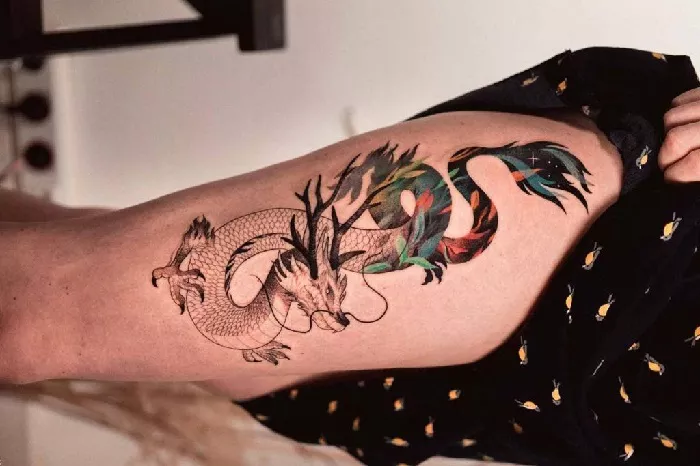When Scottish punk band The Exploited played at the Veterans Hall in Santa Cruz this March, their show drew outrage. The controversy stemmed from lead singer Wattie Buchan’s visible swastika tattoo — a symbol he has worn for decades — which ignited protests in one of California’s most liberal cities. Some even called for the concert’s cancellation.
The incident highlighted a broader truth about tattoos: once inked, a symbol or statement remains visible, even if the beliefs behind it change. Like ex-lovers living with faded names on their bodies, tattoo wearers often face a lifetime branded by a moment, a mistake, or a past identity.
But today in Santa Cruz — a place where tattoos were illegal from 1964 until 1986 — ink is no longer taboo. Now a common sight from beaches to downtown, tattoos span faces, necks, and fingers, once markings of danger or rebellion, now embraced by surfers, yoga enthusiasts, and artists alike.
Santa Cruz County is home to roughly 30 tattoo parlors. Styles have evolved, tastes have diversified, and artists have watched society shift.
“Back then, you’d come in with an idea and the artist would create it,” says Keeli Sandberg, a veteran tattooist with over 25 years of experience. “Now, people come in with screenshots on their phones. The dynamic has totally changed.”
Sandberg has witnessed the growing popularity of once-taboo placements like necks and hands. “Nobody used to get that done. That was wild back in the day,” he says. “Now you see 20-year-olds with them. It’s more accepted, which is both good and bad.”
Covering the Past, Ink by Ink
Despite changing norms, some images — like gang symbols or hate emblems — remain off-limits to most artists. Sandberg says he won’t tattoo swastikas or gang designs, but he’s covered many. “I try not to judge them,” he says. “It’s a different world in prison.”
For clients seeking change, cover-up tattoos offer a powerful alternative to expensive laser removal. Celebrity Pete Davidson famously spent over $200,000 to erase much of his ink in what he called a “health glow-up.” For the average person, though, cover-ups — when done skillfully — offer redemption, artistry, and a fresh start.
“I like doing them,” Sandberg says. “People appreciate it. Not only do they get something new, but they get rid of something that doesn’t represent them anymore.”
Sandberg’s own tattoo journey began in middle school, doing stick-and-pokes under desks at New Brighton. Inspired by his war veteran grandfather’s classic tattoos, he knew early on that ink would be part of his life. After working in Southern California, he returned to Santa Cruz and joined Freedom Tattoo — Watsonville’s first legal shop — in 2008.
Freedom Tattoo: A Fight for the First Amendment
Freedom Tattoo exists today because of a fight for constitutional rights. Geoff Wells, a certified Harley-Davidson mechanic, never planned to open a tattoo studio. But when the economy crashed in 2007 and his motorcycle shop, “Motor Cyco,” struggled, he saw an unmet need in Watsonville: a place to get tattoos.
There was one problem — tattooing was illegal in Watsonville.
Geoff wasn’t a tattooist, but he had long been immersed in the culture, building makeshift machines and getting inked since his teens. When he decided to open a shop, he turned to his mother, civil rights attorney Kathleen Wells, who believed they could overturn the outdated ordinance.
“She told me we could beat the law,” Geoff recalls. “That’s all I needed to hear.”
Together, they took on the city — through courtrooms and council chambers — and after 18 months, they won. Tattooing was legalized in Watsonville.
“I couldn’t have done it without my mom,” he says.
Geoff opened Freedom Tattoo in 2008, naming it to reflect the victory. Since then, the shop has built a loyal following and cultivated a crew of respected artists including Nolan Hatton, Rudy Hooven, and Sandberg himself.
In 2018, the shop moved to Aptos, becoming the area’s first tattoo parlor. Seventeen years after its founding, Freedom Tattoo won Best Tattoo Parlor in Santa Cruz County and a silver medal for Best Piercing Studio, as voted by Good Times readers.
“It’s a testament to the talent of our crew and the loyalty of our amazing clientele,” Geoff says. “When people are treated right and leave with great work, they come back.”
Rising Artists and Santa Cruz’s Next Generation
Freedom Tattoo has built its reputation not just on skill, but on mentorship. One of its newest resident artists, Reyna Segura Gallardo, began her career tattooing out of her garage. In 2022, Geoff brought her on as an apprentice. Today, Reyna specializes in Chicano fine line art, a culturally rich style born in California’s Mexican-American communities, known for its emotional depth and single-needle precision.
Another artist, Abraham Garduño — known as “A-bomb” — started after buying a tattoo machine from Amazon. Word of his talent spread in his community, eventually leading to an apprenticeship under Freedom artist “Rooster.” A-bomb now works full-time, focusing on black-and-grey and traditional designs.
Lights Out: A New Era of Educated Ink
Not far away, another shop is making its mark. Lights Out, also in Aptos, is co-owned by UCSC graduate Drew Nelson and Azusa Pacific alum Domonique Nevarez. Both met at Triton Tattoo after art school and decided to launch their own venture in 2021.
Despite warnings from peers that Santa Cruz had too many tattoo shops already, they pushed forward — and succeeded.
“Clientele go to artists, not shops,” says Drew. “We were lucky our clients followed us.”
Lights Out is now a thriving hub for popular styles like fineline, blackwork, realism, illustrative, and surrealism. With appointments booked three months out, Drew and Domonique are already planning an expansion next door.
“Tattooing is a great way to make a living in Santa Cruz,” says Drew. “It’s art, community, and expression — all in one.”
Related topics:

